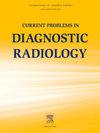Quality improvement project: Patient-centered breast imaging letters
IF 1.5
Q3 RADIOLOGY, NUCLEAR MEDICINE & MEDICAL IMAGING
引用次数: 0
Abstract
Purpose
Assess patient-centered revisions to our institution’s screening mammography letters for BIRADS-0 and BIRADS-0 dense breast employing existing validated readability and usability rating instruments.
Methods/approach
Cross-sectional analysis of two different mammography recall letters used by our institution revised to be patient-centered: the mammography recall letter (BIRADS 0) and the recall letter for patients with dense breasts (BIRADS 0-DB). During the editorial stage, we used chat GPT v3.5 and the Flesch-Kincaid grade level (FKGL). After updates to the layout and addition of visuals, the letters were rated by professional subject-matter experts (SME) for understandability and actionability using the Patient Education Materials Assessment Tool (PEMAT). The letters were then evaluated by patients for comprehensibility, utility, and design using the Consumer Information Rating Form (CIRF). Descriptive statistics were calculated for each assessment.
Results
Baseline BI-RADS 0 and BI-RADS 0-DB letter FKGL levels were 11.9 and 10.7, respectively; after iterative revision the FKGL were 6.7 and 5.8, respectively. PEMAT ratings for understandability for the BI-RADS 0 recall letter improved from 41 to 90 % after the revision, and for actionability improved from 50 to 88 %. The understandability for the revised BI-RADS 0-DB letter improved from 46 to 85 % and actionability improved from 44 to 73 %. CIRF ratings indicated significant value for the added images in the BIRADS-0-DB letter.
Conclusion
Use of validated and established assessment tools confirmed that our new breast imaging letters were improved in terms of readability, understandability/comprehensibility, actionability, utility, and design. The process now serves as a pipeline for future revisions to documents that our department is sharing with patients
质量改进项目:以患者为中心的乳腺成像字母。
目的:采用现有的经验证的可读性和可用性评级工具,评估以患者为中心的BIRADS-0和BIRADS-0致密乳腺筛查乳房x光检查信的修订。方法/方法:横断面分析我们机构修改为以患者为中心的两种不同的乳房x光检查召回信:乳房x光检查召回信(BIRADS 0)和致密乳房患者的召回信(BIRADS 0- db)。在编辑阶段,我们使用了聊天GPT v3.5和Flesch-Kincaid等级级别(FKGL)。在更新布局和添加视觉效果后,这些信件由专业主题专家(SME)使用患者教育材料评估工具(PEMAT)对可理解性和可操作性进行评级。然后由患者使用消费者信息评分表(CIRF)对信件的可理解性、实用性和设计进行评估。对每个评估进行描述性统计。结果:基线BI-RADS 0和BI-RADS 0- db字母FKGL水平分别为11.9和10.7;迭代修正后FKGL分别为6.7和5.8。修订后,BI-RADS 0召回信的PEMAT可理解性评分从41%提高到90%,可操作性评分从50%提高到88%。修订后的BI-RADS 0-DB字母的可理解性从46%提高到85%,可操作性从44%提高到73%。CIRF评级表明,在BIRADS-0-DB字母中添加的图像具有显著价值。结论:使用经过验证和建立的评估工具证实,我们的新乳房成像字母在可读性,可理解性/可理解性,可操作性,实用性和设计方面得到了改善。这个流程现在作为我们部门与患者共享的文件的未来修订的管道。
本文章由计算机程序翻译,如有差异,请以英文原文为准。
求助全文
约1分钟内获得全文
求助全文
来源期刊

Current Problems in Diagnostic Radiology
RADIOLOGY, NUCLEAR MEDICINE & MEDICAL IMAGING-
CiteScore
3.00
自引率
0.00%
发文量
113
审稿时长
46 days
期刊介绍:
Current Problems in Diagnostic Radiology covers important and controversial topics in radiology. Each issue presents important viewpoints from leading radiologists. High-quality reproductions of radiographs, CT scans, MR images, and sonograms clearly depict what is being described in each article. Also included are valuable updates relevant to other areas of practice, such as medical-legal issues or archiving systems. With new multi-topic format and image-intensive style, Current Problems in Diagnostic Radiology offers an outstanding, time-saving investigation into current topics most relevant to radiologists.
 求助内容:
求助内容: 应助结果提醒方式:
应助结果提醒方式:


